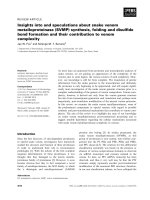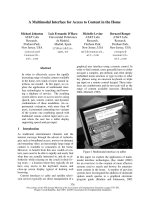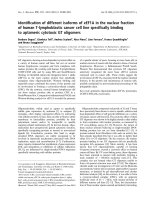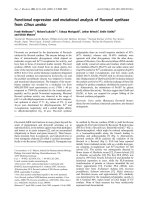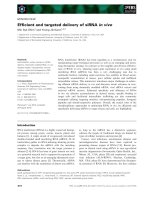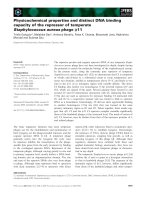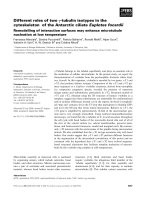Báo cáo khoa học: Protein folding and disulfide bond formation in the eukaryotic cell pptx
Bạn đang xem bản rút gọn của tài liệu. Xem và tải ngay bản đầy đủ của tài liệu tại đây (118.31 KB, 7 trang )
MEETING REPORT
Protein folding and disulfide bond formation in the
eukaryotic cell
Meeting report based on the presentations at the European Network
Meeting on Protein Folding and Disulfide Bond Formation 2009
(Elsinore, Denmark)
Adam M. Benham
Biological and Biomedical Sciences, Durham University, UK
Introduction
Protein folding in a living cell does not usually happen
spontaneously. Many factors, including chaperones,
regulatory enzymes, and redox components, exist to
help different proteins find the right path to their
shape and activity [1]. Protein misfolding can lead to
disease through either loss or gain of an individual
protein’s function [2,3], or through more general
mechanisms, e.g. when mischarged tRNAs result in
misfolded protein accumulation in the neuronal
cytoplasm [4]. The intracellular environment in which
protein folding occurs has a major influence on how a
protein folds [5]. For example, the folding status of
nucleoporins has emerged as an important regulatory
step in governing the transport of proteins through the
nuclear pore complex [6]. Regulation of protein quality
control is also important at the surface or outside the
cell, one example being to control fibrin activity during
blood coagulation [7]. However, the meeting in
Keywords
chaperone; endoplasmic reticulum;
mitochondria; protein disulfide isomerase;
protein folding; redox regulation
Correspondence
A. Benham, Biological and Biomedical
Sciences, Durham University, South Road,
Durham DH1 3LE, UK
Fax: +44 191 334 1201
Tel: +44 191 334 1259
E-mail:
(Received 19 August 2009, revised 23
September 2009, accepted 25 September
2009)
doi:10.1111/j.1742-4658.2009.07409.x
The endoplasmic reticulum (ER) plays a critical role as a compartment for
protein folding in eukaryotic cells. Defects in protein folding contribute to
a growing list of diseases, and advances in our understanding of the molec-
ular details of protein folding are helping to provide more efficient ways of
producing recombinant proteins for industrial and medicinal use. More-
over, research performed in recent years has shown the importance of the
ER as a signalling compartment that contributes to overall cellular homeo-
stasis. Hamlet’s castle provided a stunning backdrop for the latest Euro-
pean network meeting to discuss this subject matter in Elsinore, Denmark,
from 3 to 5 June 2009. Organized by researchers at the Department of
Biology, University of Copenhagen, the meeting featured 20 talks by both
established names and younger scientists, focusing on topics such as oxida-
tive protein folding and maturation (in particular in the ER, but also in
other compartments), cellular redox regulation, ER-associated degradation,
and the unfolded protein response. Exciting new advances were presented,
and the intimate setting with about 50 participants provided an excellent
opportunity to discuss current key questions in the field.
Abbreviations
ER, endoplasmic reticulum; Ero1, endoplasmic reticulum oxidoreductase 1; HLA, human leukocyte antigen; LDLR, low-density lipoprotein
receptor; MHC, major histocompatibility complex; PDI, protein disulfide isomerase; UPR, unfolded protein response; VAP-B, vesicle-
associated membrane protein-associated protein-B.
FEBS Journal 276 (2009) 6905–6911 ª 2009 The Author Journal compilation ª 2009 FEBS 6905
Elsinore focused mainly on protein folding in the
eukaryotic endoplasmic reticulum (ER) and mitochon-
dria. An important consideration in these compart-
ments is the requirement for disulfide bonds, which
form between the SH groups (thiols) of two cysteine
residues in a relatively oxidizing environment. The
disulfide bond offers structural stability, and may con-
tribute to a native protein’s enzymatic function or reg-
ulation. The formation of protein disulfides is
catalysed by thiol–disulfide oxidoreductases through
thiol–disulfide exchange reactions. These enzymes have
the capacity to oxidize, reduce or isomerize disulfide
bonds, and how and when these different activities
come into play is the subject of much current research.
There are also a surprisingly large number of thiol–
disulfide oxidoreductase and related genes in the
human genome, and understanding their specific func-
tions and interrelationships is of considerable impor-
tance, given their value to industry and medicine.
Protein folding in vitro and in vivo
In vitro approaches have long provided the basis on
which to understand the complexity of protein folding
in vivo. S. Ventura (Barcelona, Spain) discussed the
challenges of elucidating the folding pathways of disul-
fide bond-containing proteins [8]. The Ventura group
and others have made considerable progress in studying
three model proteins from human pests, namely the car-
boxypeptidase inhibitors from the leech and from the
tick, and the leech tryptase inhibitor. Structures of these
intermediates have been solved, and the folding path-
ways reveal some surprises. The tick carboxypeptidase
inhibitor turns out to be rather flexible, and can fold
either from the N-terminal domain first or the C-termi-
nal domain first. The restrictions imposed by the fold-
ing pathway limit the theoretical possibilities for
forming disulfide bonds. Lessons learned from these
model proteins are now being applied to bigger chal-
lenges, such as the low-density lipoprotein receptor
(LDLR) and its domains [9]. Calcium seems to compete
with disulfide bond formation in the LDLR, and in the
presence of this cation, non-native disulfide bonds
predominate. LDLR mutants that cause familial hyper-
cholesterolaemia tend to end up in insoluble aggregates
because they cannot attain the native state.
Folding of immunoglobulin domain
proteins
Antibodies have long been favourite subjects for stud-
ies on protein folding. They are of crucial biological
importance for adaptive immune defence, and can
cause serious mischief when they are inappropriately
produced, e.g. in autoimmune diseases. Improvements
in the efficiency of antibody production in heterolo-
gous systems would also be welcomed by industry. M.
Feige and M. Marcinowski from the Buchner labora-
tory (Munich, Germany) discussed some very elegant
work showing that the soft spot of an antibody is its
C
H
1 domain [10]. Antibodies are composed of a basic
unit of two heavy and two light chains, each of which
has repeating units of ‘constant’ or ‘variable’ immuno-
globulin domains, with the variable regions contribut-
ing to antibody diversity. NMR analysis showed that,
unlike the CL domain, the C
H
1 domain of IgG does
not fold properly in isolation. The C
H
1 domain needs
the context of CL for productive antibody folding and
assembly, and the mechanism appears to be conserved
between different immunoglobulin classes and between
species. The data suggest that proline isomerization at
the conserved Pro32 is a rate-limiting step that pre-
cedes covalent linkage of the heavy and light chains.
This is consistent with reports that the ER chaperone
BiP targets the C
H
1 domain [11,12], and labelled
peptide-binding studies are ongoing to reveal the
details of the BiP–C
H
1 interaction.
For some antibodies, assembly into a light chain–
heavy chain complex is not the end of the story.
M. Cortini from the Sitia group (Milan, Italy) explained
how IgM has the added problem of forming pentamers
in the ER prior to export [13]. It seems that IgM uti-
lizes a platform consisting of the ER–Golgi intermedi-
ate compartment transport protein 53 (ERGIC53) and
the protein disulfide isomerase (PDI) family member
ERp44. IgM glycosylation mutants have been used to
investigate how the assembly process occurs, and it
appears that glycans may act as molecular spacers to
ensure correct positioning of IgM subunits during pen-
tamerization. Major histocompatibility complex
(MHC) molecules are also critical to the immune
response, and share structural similarities with anti-
bodies, being built from the same domain prototype.
M. van Lith (Durham, UK) described how quality
control of classical MHC class II proteins compared
with that of the MHC chaperone human leukocyte
antigen (HLA)-DM. HLA-DM does not bind antigenic
peptides, unlike its cousins HLA-DP, HLA-DQ and
HLA-DR [14]. Interestingly, the DMa glycan at
Asn165 is partially endoglycosidase H-sensitive, pro-
viding another example of how topological constraints
can influence post-translational modifications.
It is not just endogenous proteins that fold in the
ER. Infectious viruses rely on the host ER to help
manufacture their coat proteins, and A. Land (Utr-
echt, The Netherlands) described how complex this is
Protein folding and disulfide formation A. M. Benham
6906 FEBS Journal 276 (2009) 6905–6911 ª 2009 The Author Journal compilation ª 2009 FEBS
for HIV. The major envelope protein of HIV is gp160,
which is cleaved into gp120 and gp41 subunits. Gp160
has 10 disulfide bonds and folds very slowly in the
ER, but needs to do so in order to keep the amount of
productively folded protein high. The leader peptide of
gp160 is removed after synthesis, and its rate of
removal both determines, and is determined by, fold-
ing of the protein, suggesting that the signal peptide
helps to control the efficiency of envelope production
[15].
PDI
PDI is the father of disulfide bond catalysts, but has
long resisted attempts to solve its crystal structure [16].
Now, PDI has yielded its secrets, and H. Schindelin
(Wu
¨
rzburg, Germany) described how this protein’s
form was finally revealed [17,18]. Two yeast PDI struc-
tures, a ‘twisted U’ and an ‘open boat’, are related by
large-scale conformational changes, and provide snap-
shots of how the protein might bind substrates and
interact with electron acceptors such as ER oxidore-
ductase 1 (Ero1). Interpreting the crystal structures of
PDI would not have been possible without the knowl-
edge gained from a series of NMR studies on the
protein, and K. Wallis from R. Freedman’s laboratory
(Warwick, UK) explained the latest approaches to
studying ligand binding to human PDI in solution.
The x-linker region, a 20 amino acid spacer between
the b¢ and a¢ domains, is likely to play an important
role in controlling binding of substrates [19,20]. Look-
ing forward, the combination of dynamic NMR stud-
ies and specific higher-resolution crystal structures and
costructures will surely provide a wealth of informa-
tion about the function of PDI and its homologues
over the next few years.
Redox control in the ER
The PDI–Ero1 system of catalysing disulfide bonds in
the ER has received a lot of attention recently, but M.
Csala (Budapest, Hungary) reminded us that proteins
and glutathione are not the only redox-active compo-
nents of the ER. Pyridine nucleotides (NADP
+
⁄
NADPH) have been rather overlooked, but may be
particularly important in some diseases, such as meta-
bolic syndrome, and during cortisol generation in adi-
pogenesis [21]. L. Ruddock (Oulu, Finland) reinforced
the point that alternative pathways for disulfide bond
formation in the ER should not be ignored: glutathi-
one, vitamin K and ascorbate all have a role to play in
determining the functional ER redox environment.
Consideration should be given to whether significant
peroxide generation occurs during disulfide bond for-
mation, an issue that has implications for cellular
stress and hypoxia [22]. The ER may well harbour
PDI peroxidases that minimize exposure to intracellu-
lar peroxide and reduce the risk of free radical gene-
ration. Indeed, the ER shows great resilience to
oxidative insults. C. Appenzeller-Herzog from the
Ellgaard group (Copenhagen, Denmark; Basel,
Switzerland) presented data showing how cells exposed
to reducing stress rapidly re-establish equilibrium, a
process that may be controlled, in part, by Ero1a [23].
In this connection, peroxiredoxin IV is emerging as a
key player in dealing with the consequences of disul-
fide bond formation in the ER [24]. N. Bullied (Man-
chester, UK) described how this protein was identified
in a client screen using the PDI homolog ERp46 as
bait. Peroxiredoxin IV knockdown results in hypersen-
sitivity to ER stress, and it can sense the reduction
potential of the ER by cycling between the cysteine
thiol form and the hyperoxidized cysteine sulfenic acid
(–SOH) form. The molecular details of how this
enzyme operates alongside oxidative and reductive
pathways of protein folding, and thus functions to help
maintain balanced ER redox conditions, are sure to
emerge in the coming years.
Protein targeting and disulfide bond
formation in mitochondria
Not only must proteins fold in the ER, but they must
also be targeted to the right intracellular or extracel-
lular destination. The problem is even more challeng-
ing for C-tail-anchored proteins, which must be
targeted to membranes post-translationally [25]. Vesi-
cle-associated membrane protein-associated protein-B
(VAP-B) has a role in vesicle trafficking, and the
mutation P56S in VAP-B can cause the familial neu-
rodegenerative disorder amyotrophic lateral sclerosis
type 8. However, the underlying mechanism of this
tail-anchored protein’s role in disease is not estab-
lished. E. Fasana from the Borgese group (Milan,
Italy) described some very interesting data, showing
that the transmembrane segment of VAP-B is rather
inefficient at inserting into membranes. Mutant VAP-B
does not route properly, but accumulates in ER
membrane-derived inclusions, which contain a number
of ER chaperones, such as calnexin and PDI. As
VAP-B is ubiquitously expressed, it will be revealing
to determine why the defect hits neurons so hard. Is
loss of function of vesicle trafficking over long dis-
tances, or gain of ER toxicity in long-lived cells, at
the root of the disease process in amyotrophic lateral
sclerosis type 8?
A. M. Benham Protein folding and disulfide formation
FEBS Journal 276 (2009) 6905–6911 ª 2009 The Author Journal compilation ª 2009 FEBS 6907
The ER is not the only compartment where disulfide
bonds are made. The intermembrane space of the
mitochondrion supports similar activity [26]. J. Riemer
(Kaiserslautern, Germany) and B. Morgan from H.
Lu’s group (Manchester, UK) described how Mia40
and Erv1 catalyse disulfide bond formation, with the
resultant transfer of electrons to cytochrome c, gener-
ating water from oxygen through the action of cyto-
chrome c oxidase. This formation of disulfide bonds
drives substrate import of some intermembrane space
proteins from the cytosol through the translocator of
the outer mitochondrial membrane complex. The clas-
sic substrates of the Erv1–Mia40 pathway are small
proteins with either twin Cx
9
C or twin Cx
3
C motifs,
e.g. Cox19 and Tim9. The oxidative folding of Tim9
determines its rate of transport, and zinc may play a
chaperone-like role, by initiating a conformational
change of Tim9 prior to transport [27].
Recombinant proteins and toxins
Sometimes, thiol–disulfide chemistry can surprise us
in vitro as well as in vivo. R. Nielsen from the Winther
laboratory (Copenhagen and NovoNordisk, Denmark)
introduced the concept of protein trisulfides, and
explained how these unexpected covalent modifications
could occur during industrial recombinant protein pro-
duction of growth hormone, interleukin-6, and super-
oxide dismutase [28]. Although this modification
probably occurs during the workup of proteins, a bio-
logical effect of this conversion should not necessarily
be excluded. The proposed mechanism of generation
of a trisulfide from a disulfide involves the production
of hydrogen sulfide, which has been ascribed a poten-
tial signalling role [29].
Protein folding in plants probably receives much less
attention than it deserves. Plants produce some potent
toxins, such as the castor bean heterodimer ricin,
which is fatal to humans at a 500 lg dose. R. Marshall
and R. Spooner (Warwick, UK) presented work that
explained how ricin synthesis is controlled, and how it
exerts its toxic effect on mammalian cells by inactivat-
ing the ribosome. Using tobacco protoplasts to study
individual ricin chains, it is possible to dissect out the
folding and trafficking requirements that take the pro-
tein into the vacuole for storage, or into the cytosol
from the ER. The AAA-ATPase p97 plays a critical
role in this decision process [30]. Upon binding to the
surface of mammalian cells, ricin gains access to the
cell’s interior by retrograde transport. The ricin A
chain is retrotranslocated into the cytosol from the
ER, but first has to be reduced, making ricin A an
excellent model for studying the molecular details of
ER-associated degradation. Current work is focused
on the Hsp40–Hsc70 system, which may control the
decision between ricin A retention in the ER and its
ubiquitination, and hence proteasomal degradation, in
the cytoplasm [31].
Protein turnover
Oxidative protein folding in the cytoplasm itself is
rare. Instead, the reductive ‘antioxidant’ environment
is (partly) maintained by the oxidoreductase thiore-
doxin. R. Hartmann-Petersen (Copenhagen, Denmark)
discussed a thioredoxin-related protein called
Txn11 ⁄ TRP32, which has emerged as a new subunit of
the 26S proteasome [32,32a]. The expression of Txn11
is widespread, but its specific function in proteasomal
activity is not yet known. However, there are some
tantalizing clues to its job: the Txn11 subunit targets
eEF1A, which, besides its role in protein translation,
has been reported to mediate proteasomal degradation
of misfolded proteins. Alternatively, Txn11 may play a
role in proteasome assembly.
Proteasomal destruction of proteins is an energy-
consuming business, and the cell tries hard to fold
miscreant proteins before giving up on them. The
unfolded protein response (UPR) is one such mecha-
nism, whereby membrane-spanning stress sensors such
as Ire1 detect unfolded proteins in the ER and facili-
tate the upregulation of ER chaperones. E. van Anken,
from P. Walter’s laboratory (San Francisco, CA,
USA), described how yeast has been used as a model
to visualize Ire1p ER stress signalling foci and to track
their appearance microscopically in real time [33]. This
major development in imaging the ER stress response
in vivo promises to provide a wealth of data about the
physiological management of ER stress, and it will be
interesting to see how similar technologies can be used
to study stress foci in higher organisms, where the ER
stress response is more complex [33a].
Conclusions
There have been a number of major advances in the
field over the past few years. One of the most impor-
tant breakthroughs has been the emergence of the
Ero1 [34] and PDI crystal structures [17]. This has
been accompanied by a wave of related PDI family
structures [35–37], and raises the real prospect that
PDI–Ero1 or PDI–client structures may be solved in
the near future. Such cocrystals will help to provide a
molecular explanation of how a disulfide isomer-
ase ⁄ oxidoreductase solves the problem of recognizing
non-native structural elements in specific proteins. A
Protein folding and disulfide formation A. M. Benham
6908 FEBS Journal 276 (2009) 6905–6911 ª 2009 The Author Journal compilation ª 2009 FEBS
second important advance in this area is the emergence
of other redox regulatory mechanisms in the ER.
Given the intense interest in oxidative stress and dis-
ease, this area will probably provide a focus for much
research activity and discovery in the next few years.
The realization that mitochondria also host a disulfide
bond relay system spawned a flurry of activity in this
area, and the race is still on to define the full range of
clients, their effects on mitochondrial metabolism, and
how misfolded mitochondrial proteins are eliminated.
Another key concept is that folding quickly is not
always the best thing for a protein, as demonstrated at
this meeting for HIV gp160 [15]. One would expect to
see more examples of how folding speed affects a pro-
tein’s biological activity emerge in the literature over
the next few years. The detection and turnover of mis-
folded ER proteins (by the UPR–ER-associated degra-
dation–proteasome axis) has been a hot topic for some
time, and we are likely to continue to witness major
breakthroughs here as well, particularly with the
advent of tools for the visualization of UPR foci in
living cells. Pharmaceuticals that target, or behave as,
molecular chaperones have been developed, e.g. in an
animal model of type 2 diabetes [38]. The tailoring of
such compounds to steer the folding and turnover of
specific target proteins in the clinic should therefore be
possible for a number of diseases where protein
misfolding is a major component [39].
In a round-up discussion led by I. Braakman (Utr-
echt, The Netherlands), the community identified a
number of key questions that still need to be addressed
to take this exciting area of research forwards into the
future. Indeed, obtaining accurate measurements of the
concentrations, distributions and flux of all the main
players involved in protein folding in the ER in vivo is
still a fundamental challenge. Whereas we know what
many protein foldases and catalysts can do, we do not
always know what they actually do in their tissue-spe-
cific environments. Oxygen and other gases, redox and
nutrient conditions are likely to differ considerably
both within and between tissues, and are not always
the same as the controlled conditions used to study
cells and proteins in tissue culture or in vitro. The
meeting concluded with real enthusiasm for the chal-
lenges ahead, and a sense of pride that the field was
moving forwards so rapidly, with plenty of room for
cooperation, collaboration and open discussion of new
scientific concepts.
Acknowledgements
The author thanks the participants of the meeting for
critical comments on the manuscript, and for sharing
details of unpublished work. The organizers (L. Ellg-
aard and J. R. Winther, Department of Biology,
University of Copenhagen, Denmark) wish to thank
members of their groups for practical help in setting
up the meeting, and D. Theodoraki for excellent
administrative support. The work in the authors’ labo-
ratory was supported by grants from the BBSRC
(grant number BB⁄ C509582), the Wellcome Trust,
the Leverhulme Trust, and the Arthritis Research
Campaign.
References
1 Christis C, Lubsen NH & Braakman I (2008) Protein
folding includes oligomerization; examples from the
endoplasmic reticulum and cytosol. FEBS J 275, 4700–
4727.
2 Otsu M & Sitia R (2007) Diseases originating from
altered protein quality control in the endoplasmic retic-
ulum. Curr Med Chem 14, 1639–1652.
3 Winklhofer KF, Tatzelt J & Haass C (2008) The two
faces of protein misfolding: gain- and loss-of-function
in neurodegenerative diseases. EMBO J 27, 336–349.
4 Lee JW, Beebe K, Nangle LA, Jang J, Longo-Guess
CM, Cook SA, Davisson MT, Sundberg JP, Schimmel
P & Ackerman SL (2006) Editing-defective tRNA syn-
thetase causes protein misfolding and neurodegenera-
tion. Nature 443, 50–55.
5 Kelly JW & Balch WE (2006) The integration of cell
and chemical biology in protein folding. Nat Chem
Biol 2, 224–227.
6 Patel SS, Belmont BJ, Sante JM & Rexach MF (2007)
Natively unfolded nucleoporins gate protein diffusion
across the nuclear pore complex. Cell 129, 83–96.
7 Reinhardt C (2008) Protein disulfide isomerase acts as
an injury response signal that enhances fibrin genera-
tion via tissue factor activation. J Clin Invest 118,
1110–1122.
8 Arolas JL, Castillo V, Bronsoms S, Aviles FX &
Ventura S (2009) Designing out disulfide bonds of
leech carboxypeptidase inhibitor: implications for its
folding, stability and function. J Mol Biol 392, 529–
546.
9 Arias-Moreno X, Arolas JL, Aviles FX, Sancho J &
Ventura S (2008) Scrambled isomers as key intermedi-
ates in the oxidative folding of ligand binding module
5 of the low density lipoprotein receptor. J Biol Chem
283, 13627–13637.
10 Feige MJ, Groscurth S, Marcinowski M, Shimizu Y,
Kessler H, Hendershot LM & Buchner J (2009) An
unfolded CH1 domain controls the assembly and
secretion of IgG antibodies. Mol Cell 34, 569–579.
11 Lee Y-K, Brewer JW, Hellman R & Hendershot LM
(1999) BiP and immunoglobulin light chain cooperate
A. M. Benham Protein folding and disulfide formation
FEBS Journal 276 (2009) 6905–6911 ª 2009 The Author Journal compilation ª 2009 FEBS 6909
to control the folding of heavy chain and ensure the
fidelity of immunoglobulin assembly. Mol Biol Cell 10,
2209–2219.
12 Kaloff CR & Haas IG (1995) Coordination of immu-
noglobulin chain folding and immunoglobulin chain
assembly is essential for the formation of functional
IgG. Immunity 2, 629–637.
13 Anelli T, Ceppi S, Bergamelli L, Cortini M, Masciarelli
S, Valetti C & Sitia R (2007) Sequential steps and
checkpoints in the early exocytic compartment during
secretory IgM biogenesis. EMBO J 26, 4177–4188.
14 van Lith M & Benham AM (2006) The DMalpha and
DMbeta chain cooperate in the oxidation and folding
of HLA-DM. J Immunol 177, 5430–5439.
15 Land A, Zonneveld D & Braakman I (2003) Folding
of HIV-1 envelope glycoprotein involves extensive
isomerization of disulfide bonds and conformation-
dependent leader peptide cleavage. FASEB J 17,
1058–1067.
16 Hatahet F & Ruddock LW (2007) Substrate recogni-
tion by the protein disulfide isomerases. FEBS J 274,
5223–5234.
17 Tian G, Xiang S, Noiva R, Lennarz WJ & Schindelin
H (2006) The crystal structure of yeast protein disul-
fide isomerase suggests cooperativity between its active
sites. Cell 124, 61–73.
18 Tian G, Kober F-X, Lewandrowski U, Sickmann A,
Lennarz WJ & Schindelin H (2008) The catalytic
activity of protein-disulfide isomerase requires a
conformationally flexible molecule. J Biol Chem 283,
33630–33640.
19 Nguyen VD, Wallis K, Howard MJ, Haapalainen AM,
Salo KEH, Saaranen MJ, Sidhu A, Wierenga RK,
Freedman RB, Ruddock LW et al. (2008) Alternative
conformations of the x region of human protein disul-
phide-isomerase modulate exposure of the substrate
binding b¢ domain. J Mol Biol 383, 1144–1155.
20 Byrne LJ, Sidhu A, Wallis AK, Ruddock LW,
Freedman RB, Howard MJ & Williamson RA (2009)
Mapping of the ligand binding site on the b¢ domain
of human PDI; interaction with peptide ligands and
the x-linker region. Biochem J,
doi:10.1042 ⁄ BJ20090565.
21 Csala M, Banhegyi G & Benedetti A (2006) Endoplas-
mic reticulum: a metabolic compartment. FEBS Lett
580, 2160–2165.
22 Karala AR, Lappi AK, Saaranen MJ & Ruddock LW
(2009) Efficient peroxide-mediated oxidative refolding
of a protein at physiological pH and implications for
oxidative folding in the endoplasmic reticulum.
Antioxid Redox Signal 11, 963–970.
23 Appenzeller-Herzog C, Riemer J, Christensen B,
Sorensen ES & Ellgaard L (2008) A novel disulphide
switch mechanism in Ero1[alpha] balances ER oxida-
tion in human cells. EMBO J 27, 2977–2987.
24 Tavender TJ, Sheppard AM & Bulleid NJ (2008)
Peroxiredoxin IV is an endoplasmic reticulum-localized
enzyme forming oligomeric complexes in human cells.
Biochem J 411, 191–199.
25 Borgese N, Brambillasca S & Colombo S (2007) How
tails guide tail-anchored proteins to their destinations.
Curr Opin Cell Biol 19, 368–375.
26 Riemer J, Bulleid N & Herrmann JM (2009) Disulfide
formation in the ER and mitochondria: two solutions
to a common process. Science 324, 1284–1287.
27 Morgan B, Ang SK, Yan G & Lu H (2009) Zinc can
play chaperone-like and inhibitor roles during import
of mitochondrial small Tim proteins. J Biol Chem 284,
6818–6825.
28 Thomsen M, Hansen B, Nilsson P, Nowak J, Johansen
P, Thomsen P & Christiansen J (1994) Pharmacologi-
cal characterization of a biosynthetic trisulfide-contain-
ing hydrophobic derivative of human growth hormone:
comparison with standard 22 K growth hormone.
Pharmacol Toxicol 74, 351–358.
29 Mancardi D, Penna C, Merlino A, Del Soldato P,
Wink DA & Pagliaro P (2009) Physiological and
pharmacological features of the novel gasotransmitter:
hydrogen sulfide. Biochim Biophys Acta 1787,
864–872.
30 Marshall RS, Jolliffe NA, Ceriotti A, Snowden CJ, Lord
JM, Frigerio L & Roberts LM (2008) The role of
CDC48 in the retro-translocation of non-ubiquitinated
toxin substrates in plant cells. J Biol Chem 283, 15869–
15877.
31 Spooner RA, Hart PJ, Cook JP, Pietronia P, Rogon
C, Ho
¨
hfeld J, Roberts LM & Lord JM (2008) Cyto-
solic chaperones influence the fate of a toxin dislocated
from the endoplasmic reticulum. Proc Natl Acad Sci
USA 105, 17408–17413.
32 Andersen KM, Madsen L, Prag S, Johnsen AH,
Semple CA, Hendil KB & Hartmann-Petersen R
(2009) Thioredoxin Txnl1 ⁄ TRP32 is a redox-active
cofactor of the 26 S proteasome. J Biol Chem 284,
15246–15254.
32a Wiseman RL, Chin KT, Haynes CM, Stanhill A, Xu
CF, Roguev A, Krogan NJ, Neubert TA & Ron D
(2009) Thioredoxin-related Protein 32 is an arsenite-
regulated thiol reductase of the proteasome 19 S
particle. J Biol Chem 284, 15233–15245.
33 Aragon T, van Anken E, Pincus D, Serafimova IM,
Korennykh AV, Rubio CA & Walter P (2009) Messen-
ger RNA targeting to endoplasmic reticulum stress
signalling sites. Nature 457, 736–740.
33a Ron D (2009) Targeting of mRNAs to their sites of
unconventional splicing in the unfolded protein
response. Mol Cell 34, 133–134.
34 Gross E, Kastner DB, Kaiser CA & Fass D (2004)
Structure of Ero1p, source of disulfide bonds for oxi-
dative protein folding in the cell. Cell 117, 601–610.
Protein folding and disulfide formation A. M. Benham
6910 FEBS Journal 276 (2009) 6905–6911 ª 2009 The Author Journal compilation ª 2009 FEBS
35 Kozlov G, Maattanen P, Schrag JD, Hura GL,
Gabrielli L, Cygler M, Thomas DY & Gehring K
(2009) Structure of the noncatalytic domains and glo-
bal fold of the protein disulfide isomerase ERp72
Structure 17, 651–659.
36 Vitu E, Gross E, Greenblatt HM, Sevier CS, Kaiser
CA & Fass D (2008) Yeast Mpd1p reveals the struc-
tural diversity of the protein disulfide isomerase family.
J Mol Biol 384, 631–640.
37 Kozlov G, Maattanen P, Schrag JD, Pollock S, Cygler
M, Nagar B, Thomas DY & Gehring K (2006) Crystal
structure of the bb¢ domains of the protein disulfide
isomerase ERp57. Structure 14, 1331–1339.
38 Ozcan U, Yilmaz E, Ozcan L, Furuhashi M,
Vaillancourt E, Smith RO, Gorgun CZ & Hotamisligil
GS (2006) Chemical chaperones reduce ER stress and
restore glucose homeostasis in a mouse model of type
2 diabetes. Science 313, 1137–1140.
39 Chaudhuri TK & Paul S (2006) Protein-misfolding
diseases and chaperone-based therapeutic approaches.
FEBS J 273, 1331–1349.
A. M. Benham Protein folding and disulfide formation
FEBS Journal 276 (2009) 6905–6911 ª 2009 The Author Journal compilation ª 2009 FEBS 6911

